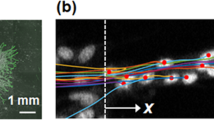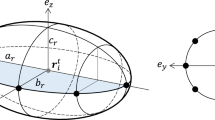Abstract
New blood vessel formation, or angiogenesis, occurs through the migration of endothelial cells in elongated sprouts. These sprouts are directed preferentially towards the inciting stimulus1–3. Several studies have demonstrated that certain chemical substances can stimulate angiogenesis4–7. In these cases, endothelial cell migration towards the chemical stimulus may be due to a preferential migration of cells from lower to higher concentrations of the mediator. Such concentration gradient-dependent cellular migration has been termed chemotaxis8. Using a modification of the Boyden chamber technique9 to measure chemotaxis in vitro, we have now found that extracts of various adult bovine tissues have potent chemotactic activity for vascular endothelial cells. Adult bovine serum lacks similar chemotactic activity.
This is a preview of subscription content, access via your institution
Access options
Subscribe to this journal
Receive 51 print issues and online access
$199.00 per year
only $3.90 per issue
Buy this article
- Purchase on Springer Link
- Instant access to full article PDF
Prices may be subject to local taxes which are calculated during checkout
Similar content being viewed by others
References
Schoefl, G. I. Virchows Arch. path. Anat. Physiol. 337, 97–141 (1963); Ann. N. Y. Acad. Sci. 116, 789–802 (1964).
Yamagami, I. Jap. J. Ophthal. 14, 41–58 (1970).
Ausprunk, D. H. & Folkman, J. Microvascular Res. 14, 53–65 (1977).
Folkman, J. Cancer Res. 34, 2109–2113 (1974).
Ben Ezra, D. Am. J. Ophthal. 86, 455–461 (1978).
Weiss, J. B., Brown, R. A., Kumar, S. & Phillips, P. Br. J. Cancer 40, 493–496 (1979).
Glaser, B. M., D'Amore, P. A., Michels, R. G., Patz, A. & Fenselau, A. J. Cell Biol. 84, 298–304 (1980).
Schiffmann, E. & Gallin, J. I. Curr. Topics Cell Regulation 15, 203–261 (1979).
Boyden, S. J. exp. Med. 115, 453–466 (1962).
Fenselau, A. H. & Mello, R. J. Cancer Res. 36, 3269–3273 (1976).
Keller, H. U., Borel, J. F., Wilkinson, P. C., Hess, M. W. & Bottier, J. J. immun. Meth. 1, 165–168 (1972).
Zigmond, S. H. & Hirsch, J. G. J. exp. Med. 137, 387–410 (1973).
Fox, I. J. & Wood, E. H. Proc. Staff Meet. Mayo Clinic 35, 732–744 (1960).
Eisenstein, R., Sorgente, N., Sohle, L. W., Miller, A. W. & Kuettner, K. E. Am. J. Path. 73, 765–774 (1973).
Ausprunk, D. H., Knighton, D. R. & Folkman, J. Am. J. Path. 79, 597–618 (1975).
Federman, J. L., Brown, G. C., Felberg, N. T. & Feiton, S. M. Am. J. Ophthal. 89, 231–237 (1980).
Author information
Authors and Affiliations
Rights and permissions
About this article
Cite this article
Glaser, B., D'Amore, P., Seppa, H. et al. Adult tissues contain chemo-attractants for vascular endothelial cells. Nature 288, 483–484 (1980). https://doi.org/10.1038/288483a0
Received:
Accepted:
Issue Date:
DOI: https://doi.org/10.1038/288483a0
This article is cited by
-
Inducible gene targeting in the neonatal vasculature and analysis of retinal angiogenesis in mice
Nature Protocols (2010)
-
The mouse cornea micropocket angiogenesis assay
Nature Protocols (2007)
-
Role of Chemokines in Angiogenesis: CXCL12/SDF‐1 and CXCR4 Interaction, a Key Regulator of Endothelial Cell Responses
Microcirculation (2003)
-
Extracapsular cataract extraction in diabetic eyes
Documenta Ophthalmologica (1995)
-
Release of an inhibitor of angiogenesis upon induction of wild type p53 expression in glioblastoma cells
Nature Genetics (1994)
Comments
By submitting a comment you agree to abide by our Terms and Community Guidelines. If you find something abusive or that does not comply with our terms or guidelines please flag it as inappropriate.



